Dairy farming is a crucial part of Pakistan’s agricultural sector, providing a livelihood for millions and contributing significantly to the economy. Pakistan is one of the world’s top milk-producing countries, with dairy farming deeply embedded in its cultural and historical roots. The evolution of dairy farming in Pakistan spans traditional methods, colonial influences, and modern advancements. Here’s an exploration of the history and development of dairy farming in the country.
1. Traditional Dairy Farming Practices
Pre-Colonial Era:
Dairy farming has been a part of the rural lifestyle in the Indian subcontinent, including the area that is now Pakistan, for centuries. Local breeds like the Nili-Ravi buffalo and Sahiwal cattle were domesticated by farmers for their milk production. Livestock rearing was integrated into daily life, with milk used for household consumption and religious rituals.
Indigenous Knowledge:
In the past, dairy farmers relied on indigenous knowledge and natural resources to manage their herds. Cattle and buffalo were often grazed on communal lands, and surplus milk was converted into dairy products like ghee (clarified butter), butter, and yogurt, which could be stored for longer periods without refrigeration.
2. Colonial Influence and Industrialization
British Colonial Period (1858-1947):
The British colonial rulers recognized the potential of the subcontinent’s dairy sector and introduced formal dairy farming practices. They established organized farms and brought European cattle breeds to improve milk yields. Dairy cooperatives were also introduced to streamline the collection and distribution of milk.
Urbanization and Demand:
During the colonial era, urbanization increased the demand for milk and dairy products in cities like Lahore, Karachi, and Rawalpindi. This created the need for organized dairy farming beyond subsistence levels. Milk was transported from rural to urban areas, and basic processing facilities were set up to ensure that city dwellers had access to fresh milk.
3. Post-Independence Period
1947 Onwards:
After the partition of India in 1947, Pakistan inherited a largely agrarian economy. The dairy sector continued to grow, with millions of small-scale farmers depending on milk production for income and sustenance. However, the industry remained informal, with limited government intervention or infrastructure for large-scale production and distribution.
Livestock Development:
In the early decades after independence, the government of Pakistan took initiatives to improve livestock breeds, with a focus on increasing milk yields. The establishment of livestock research centers and veterinary services helped improve animal health and productivity.
4. The Rise of Cooperative Models
The Cooperative Movement:
In the 1980s and 1990s, Pakistan began to see the rise of cooperative dairy models. Inspired by India’s success with cooperative dairy organizations like Amul, Pakistan launched similar projects. One of the most notable examples is the Punjab Livestock and Dairy Development Board (PLDDB), which aimed to support farmers with better breeding, feeding, and healthcare facilities for livestock.
Dairy Hubs:
Around the same time, the concept of dairy hubs began to take hold. These hubs provided a structured way for small farmers to pool their milk, which was then sold to larger companies for processing. This model helped bring more consistency and efficiency to milk production and distribution in Pakistan.
5. Modern Dairy Farming
Private Sector Investment:
In recent decades, the dairy industry in Pakistan has seen significant investment from private companies. Brands like Nestlé Pakistan, Engro Foods, and Haleeb Foods have entered the market, setting up large-scale dairy farms and processing plants. These companies have introduced modern dairy farming practices, including mechanized milking, refrigeration, and advanced breeding techniques to boost milk production.
Introduction of High-Yielding Breeds:
To increase milk production, the introduction of crossbreeding between indigenous cattle and higher-yielding foreign breeds, such as Holstein Friesians and Jersey cows, has become more common. These breeds offer higher milk output but require better management and feeding practices.
6. Challenges Facing Dairy Farming
Small-Scale Farmers:
Despite the growth of large dairy farms, a significant portion of Pakistan’s milk is still produced by small-scale farmers, often with fewer than five animals. These farmers face challenges related to low milk yields, lack of access to modern veterinary services, and poor market linkages.
Cold Chain Infrastructure:
One of the main issues facing the dairy sector is the lack of cold chain infrastructure, which is crucial for preserving milk quality from farm to consumer. A large portion of milk in Pakistan is sold unprocessed, and spoilage during transportation remains a challenge.
Feed and Fodder Issues:
Seasonal shortages of quality feed and fodder can drastically affect milk production. Poor-quality feed leads to malnutrition among cattle, resulting in lower yields and unhealthy livestock.
7. Government Initiatives and Future Prospects
Livestock Development Policies:
The government of Pakistan has introduced various programs to support the dairy industry. These include subsidies for veterinary care, improved breeding programs, and training for farmers on modern dairy practices. The focus is also on developing cold chain facilities and improving rural access to dairy markets.
Export Potential:
Pakistan’s dairy sector has enormous export potential, given the country’s large livestock population. However, significant improvements in quality control, processing standards, and international certifications are needed to tap into this market.
Dairy farming in Pakistan has evolved from traditional, small-scale practices to modern, industrialized operations. Despite challenges, the sector remains a vital part of the economy, providing employment and nutrition to millions of people. With continued investment in infrastructure, farmer education, and technology, Pakistan’s dairy industry is poised for further growth, with the potential to meet both domestic and international demand.



